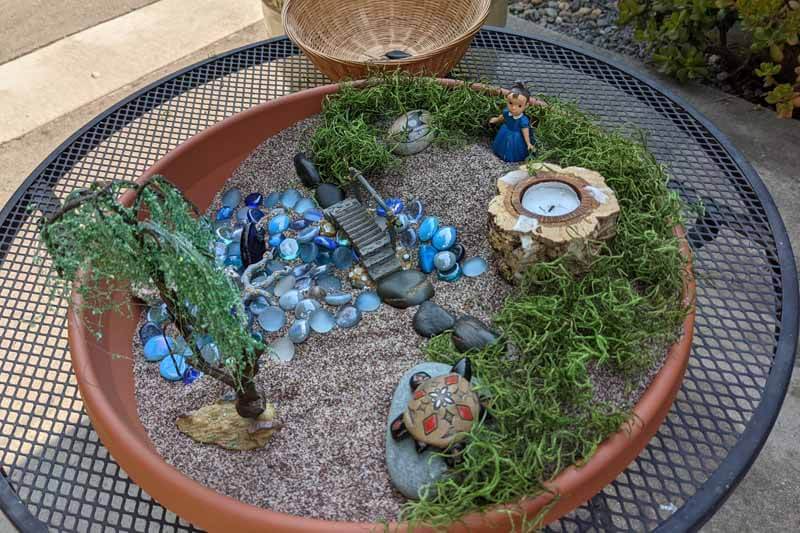- Licensed Marriage and Family Therapist
- License No. MFC 51366
- Registered Play Therapist Supervisor S2473
Sandtray Therapy
“If play is the language, then minatures are the words. Just as an empty canvas provides a place for artistic expression, so the tray provides a place for the client’s emotional expression.”
(Linda Homeyer & Daniel Sweeney, Sandtray Therapy, A Practical Manual, 1998).
What is Sandtray Therapy?
Sandtray is an imaginative activity that allows clients of any age to play or create pictures (worlds) using sand and minatures. The process requires no words or languageand the sensory experience is soothing and grounding, providing the child or teen (or adult) with a unique, non-verbal way yet tangible way to explore, share and address thoughts and feelings or work through challenges and conflicts.

Sandtray works so well because it doesn’t feel like work. Playing or creating in the sandtray is usually fun even though we’re doing more serious work and accessing the part of the brain that supports our ability to interpret, navigate and thrive in the world. Working with our hands allows us to access the part of the brain where our feelings, emotions, and earliest memories reside and bring it into our consciousness. In some ways it’s like opening a box, taking out the missing half of a picture and connecting it to the piece we already have. Being able to see a larger, more complete version of the picture allows us to think about it differently too. It’s amazing what a new perspective can do! And, when more information is shared (integrated) by different parts of the brain, our ability to develop higher skills that support our ability to thrive also increases.
FAQ's
How do sandtray therapy and sandplay therapy differ?
Though sand tray therapy and sandplay therapy both involve the use of sand for therapeutic purposes in a threat-free environment, the approaches have subtle but significant differences. For example, sand tray therapy may incorporate various theoretical orientations, whereas sandplay therapy is grounded in Jungian psychology.
Sand tray therapy emphasizes what the person in therapy is experiencing at that moment, and therapists are actively involved in facilitating current experiences of awareness and growth. As individuals in treatment are required to open up emotionally—sharing their deepest thoughts and feelings as they happen—the therapeutic relationship in sand tray therapy must be strong in order for the treatment to be effective. In contrast, sandplay therapists focus on the unconscious and seek to provide people in therapy with a free, protected space and the opportunity to communicate nonverbally. As such, sandplay therapists do not interpret, interfere with, or direct the person in therapy in any way, and analysis takes place after the therapy session.
While verbalization is an essential aspect of each sand tray session, sandplay therapy may be more effective for children or for individuals who are unable to express themselves verbally due to past trauma.
Sandtray therapy techniques
The humanistic approach is a common strategy applied in sand tray therapy. Clinicians who use this technique rely solely on the client to find solutions to their problems, using the sand as a tool for healing. Through creative expression, a person in therapy is able to manifest in sand the things they would otherwise not be able to vocalize or address in traditional therapy. The therapist treats the person as whole and healed, knowing that the process of sand tray therapy allows the person to find the answers that are already within them.
Sandtray therapy for adults
Although sand tray therapy may look like child’s play, it is a highly therapeutic and multidimensional form of therapy that can provide emotional release and realization for adults in therapy, as well. Adults who have been traumatized and show limited response to other forms of therapy may respond well to sand tray therapy. The environment presents an atmosphere free from threats, and the therapist works with the person in therapy to alter the positions of the miniature objects as representations of the true people and events.
Sand tray therapy for adults may help by beginning to facilitate change on a fictitious level, and an individual can gain the courage and ability to recognize that these same changes can be made in their own life.
While the sandplay process involves creating a series of trays and might last for months or years, some change may be experienced in just one sand tray session.